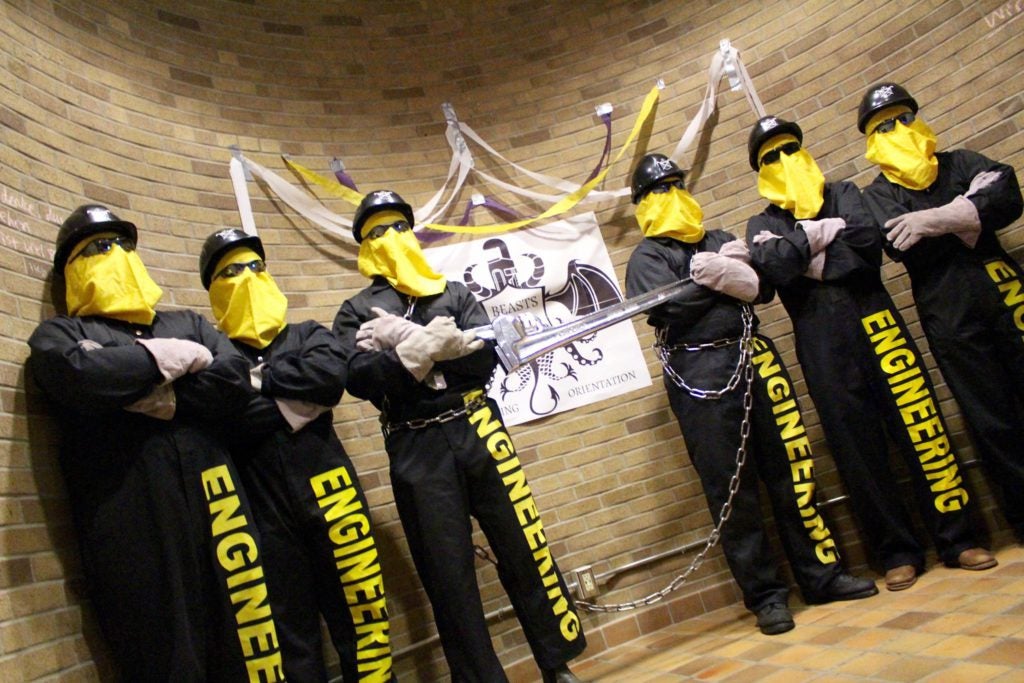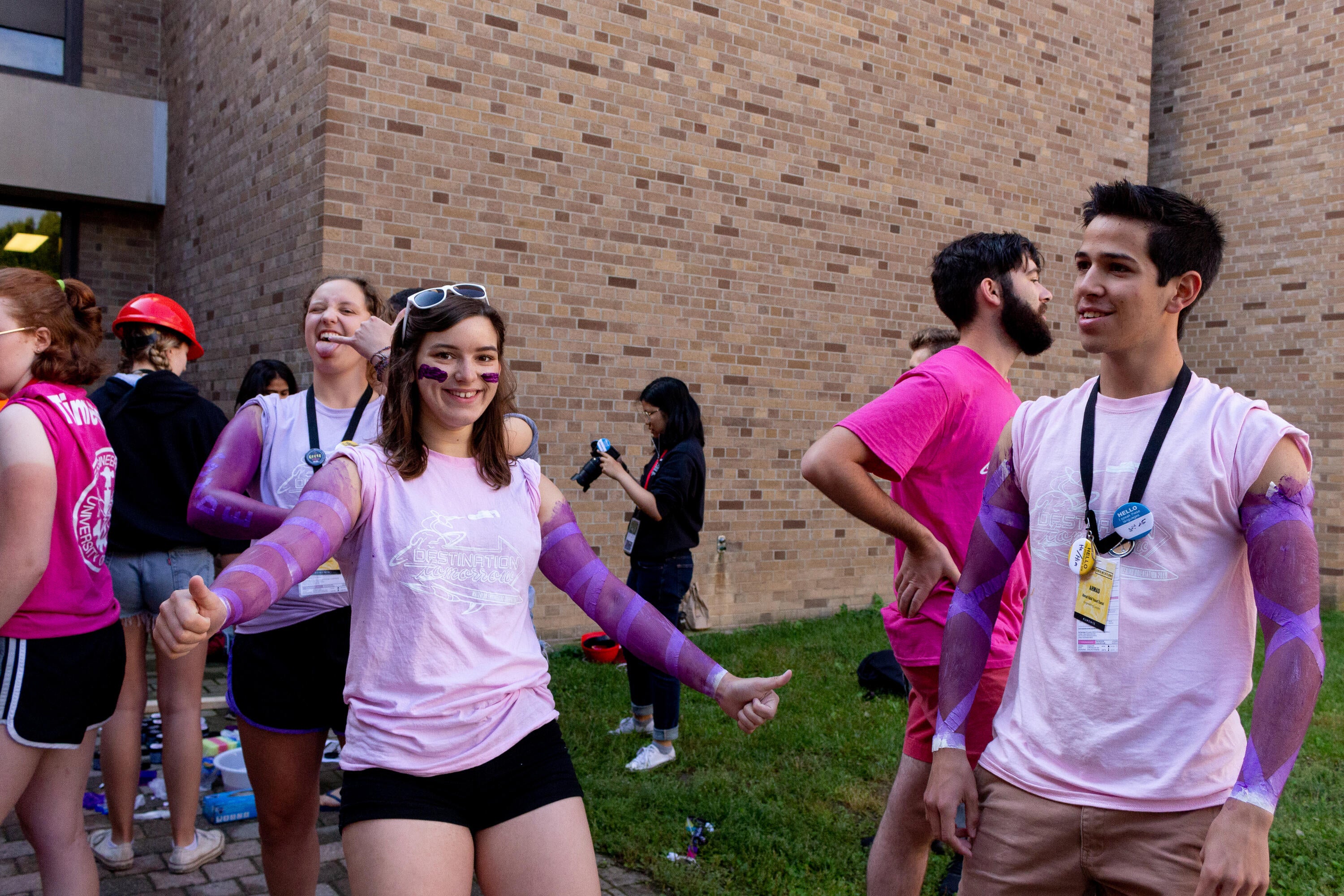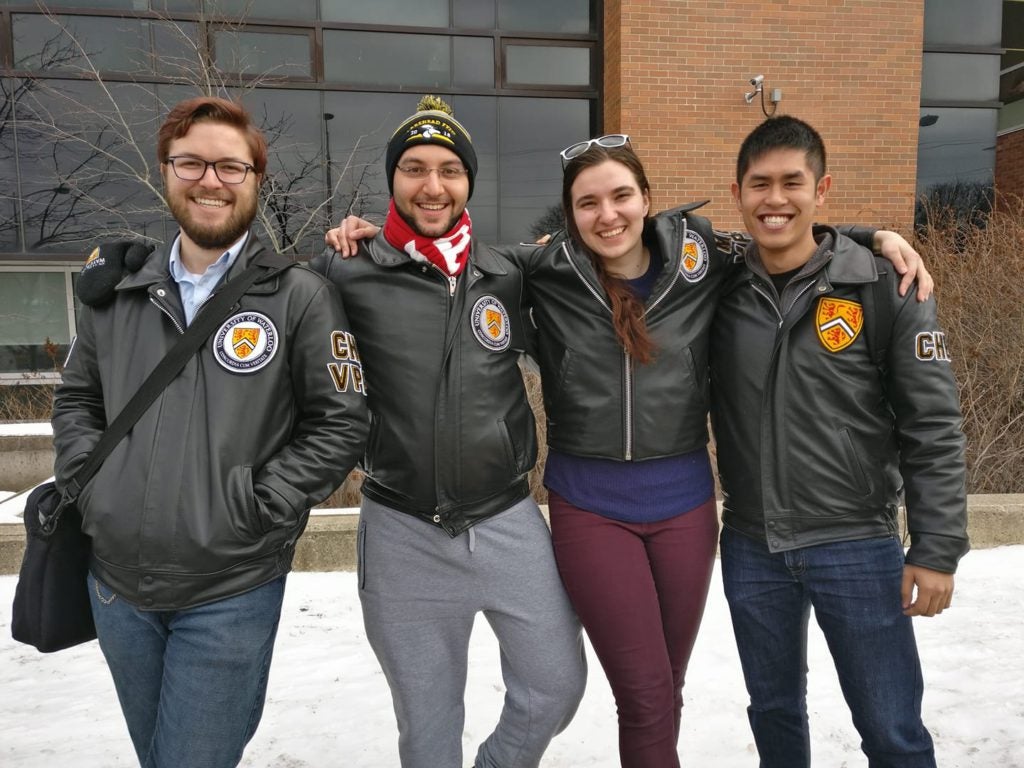EngSoc includes many traditions ranging from those practiced in most Canadian engineering departments to those uniquely to the Univeristy of Waterloo.
The Tool
The Tool is a sixty-inch triple chrome-plated adjustable pipe wrench, forged by the Ridgid Tool Company of Elyria, OH, USA. It is the only known fully chromed pipe wrench of its type in the world. This is the mascot of the University of Waterloo Engineering Society and was chosen as part of a public vote on both societies in the late 1960s. Jim Pike, A-Society President at the time, wrote to the Ridgid Tool Company and was able to get this mascot donated to the Engineering Society. This was on the condition that it would be known as "The Ridgid Tool", and that it would retain its original orange colours out of respect for the Ridgid Tool Company. Once The Tool was received in the summer of 1968, it was almost immediately chromed which unintentionally made it lose its orange colouring. Later on, it was officially renamed from "The Ridgid Tool" to "The Tool". On October 5, 1968, the Tool made its first official public appearance, at an Engineering Semi-Formal dance. From that point forward, it has been at every major event of the Engineering Society.

The Tool is guarded by a group known as Tool Bearers. They are cloaked in a black and gold uniform to not reveal their identity, and are the official guardians of the Tool in public and in private. They are responsible for showing and protecting it at major events along with the on-stream Engineering Society president. The Tool may only be touched by those who wear an Iron Ring, and is meant to act as a unifying symbol of pride for Waterloo Engineers.
In the early days of the Tool, there have been few instances where it has been stolen by another school. The most notable of these pranks happened in January 1982, when it was stolen while being transported back to Waterloo by University of Toronto students and withheld for two months.Due to the size of The Tool, a mini-Tool named "Junior" was created for the purpose of transportation to conferences and for some habitual activities like Engineering Society Council. The Tool rarely makes an appearance outside of the University as a result, most notably during the Toronto Pride Parade.
The Iron Ring
The Iron Ring is both a symbol of pride in the engineering profession and a reminder of the engineer's obligation to live by a high standard of professional conduct. The legend of the Iron Ring is that it is forged from a steel beam of the ill-fated Quebec bridge, which collapsed in 1907 due to poor engineering and planning, killing 75 construction workers. Worn on the pinky finger of one's working hand, the Iron Ring is given to 4th year students at a voluntary ceremony known as the "Ritual of the Calling of the Engineer".
The Ritual of the Calling of the Engineer has a history dating back to 1922, when seven former presidents of the Engineering Institute of Canada attended a meeting in Montréal with other engineers. One of the speakers was civil engineer Professor Haultain, of the University of Toronto. He felt that an organization was needed to bind all members of the engineering profession in Canada more closely. He also felt that an obligation or statement of ethics to which a young graduate in engineering could subscribe should be developed. The seven past-presidents of the Engineering Institute of Canada were very receptive to this idea. Haultain wrote to Rudyard Kipling, who had made reference to the work of engineers in some of his poems and writings. He asked Kipling for his assistance in developing a suitably dignified obligation and ceremony for its undertaking. Kipling was very enthusiastic in his response and shortly produced both an obligation and a ceremony formally entitled "The Ritual of the Calling of an Engineer". This ritual is colloqually called the Iron Ring Ceremony (IRC).
The objective of The Ritual can be stated as follows: The Ritual of the Calling of an Engineer has been instituted with the simple end of directing the newly qualified engineer toward a consciousness of the profession and its social significance and indicating to the more experienced engineer their responsibilities in welcoming and supporting the newer engineers when they are ready to enter the profession.
This Iron Ring Ceremony is directly followed up by the Iron Ring Stag (IRS), a celebration that occurs for the graduating class every year in the following evening. It is the first opportunity for the newly-ringed students to touch The Tool.
Purpling

Purpling is the act of dying your skin purple out of respect for the engineering profession and dedication to your school. The legend is that the engineers aboard the Titanic wore purple coveralls, and as the ship sank, they remained in the engine rooms to keep the furnaces going so that the smoke would act as a signal to other ships. They sacrificed their lives to attempt to save others. In addition, it is said that the Royal Engineers of the British Army wore a purple armband. Much like the Iron Ring, purpling is done out of respect for those that gave their lives for and because of our profession and as a reminder of the responsibility all engineers share. Over the years purpling has evolved to be a way for engineering students to show their sense of pride and cultivate engineering spirit.
Purpling at Waterloo only occurs during special event and traditions. The most common time to see purple engineers is during Orientation week when many leaders and first years dye themselves. During Summer or Fall terms there may be charity purpling events where students collect pledges to die themselves purple to raise money for charity. Additionally, once an Engineering Society president is elected, they must remained chained to a couch in CPH Foyer dyed purple from head to toe for the entire day of their initiation until the Council Meeting that evening where they are officially sworn into office.
Godiva's Hymn
The Engineering Hymn is sung across Canada by engineers with many different versus and variations. Inspired by Lady Godiva and her sadness at the plight of the poor in 11th century England the hymn recounts the tale of Godiva's husband, Leofric, who was a man of power and could have alleviated the suffering inflicted on the destitute, had he wanted to do so. He agreed to lower taxes at the request of his lovely wife, but only if she would ride a horse completely naked through the streets of Coventry, thinking that she would not go through with it. She did, but before her ride, she told the villagers of her plan and asked that they not watch her. Since then, Godiva's legendary courage has been the source of many works of art, including the Engineering Hymn.
The Hymn is sung at many engineering celebrations and has been updated over the years to in an attempt to keep up with the changing culture while still maintaining the spirit that brings Canadian Engineering students together.
Clothing
The University of Waterloo jackets have been around since the early 1960s. The jacket started as a symbol worn to show drivers that they could trust Waterloo Engineering students who were looking to hitchhike a ride to campus. The original jackets were only available to the Engineers, and were made of purple corduroy with gold lettering. Over the years this has evolved into the black leather jackets that are available to all faculties. The jackets are custom fitted, embroidered with a student's graduation year on the right sleeve, their department on the left sleeve, the Waterloo crest on the front, and "WATERLOO ENGINEERING" on the back.
Coveralls are worn as a representation of the Engineering spirit at the University of Waterloo. Starting off as swag that the Executive of the Engineering Society exclusively owned, they have expanded drastically as students craved the idea of showing off their pride of being in Engineering. Engineering Society coveralls have the Engineering Society logo on the back and "Engineering" written all the way down the left leg. On the right arm, there are two lines of embroidery, usually indicating the person's name, their program and their year of graduation. Patches are one of the main ways of decorating coveralls. They are used as a form of expressing unity, as well as personality due to the endless ways people design and decorate their coveralls. Patch trading is encouraged at a provincial and national scale, and on occasion the body parts of a coverall are traded.

